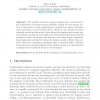Free Online Productivity Tools
i2Speak
i2Symbol
i2OCR
iTex2Img
iWeb2Print
iWeb2Shot
i2Type
iPdf2Split
iPdf2Merge
i2Bopomofo
i2Arabic
i2Style
i2Image
i2PDF
iLatex2Rtf
Sci2ools
MIG
2009
Springer
2009
Springer
Motion Pattern Encapsulation for Data-Driven Constraint-Based Motion Editing
The growth of motion capture systems have contributed to the proliferation of human motion database, mainly because human motion is important in many applications, ranging from games entertainment and films to sports and medicine. However, the captured motions normally attend specific needs. As an effort for adapting and reusing captured human motions in new tasks and environments and improving the animator’s work, we present and discuss a new data-driven constraintbased animation system for interactive human motion editing. This method offers the compelling advantage that it provides faster deformations and more natural-looking motion results compared to goal-directed constraint-based methods found in the literature.
| Added | 27 May 2010 |
| Updated | 27 May 2010 |
| Type | Conference |
| Year | 2009 |
| Where | MIG |
| Authors | Schubert R. Carvalho, Ronan Boulic, Daniel Thalmann |
Comments (0)

